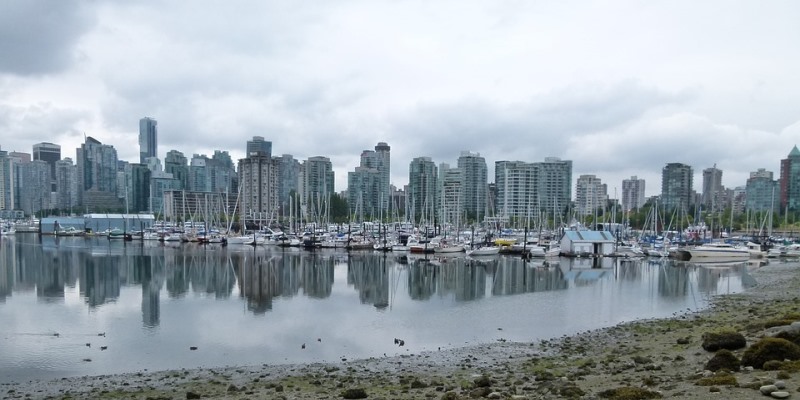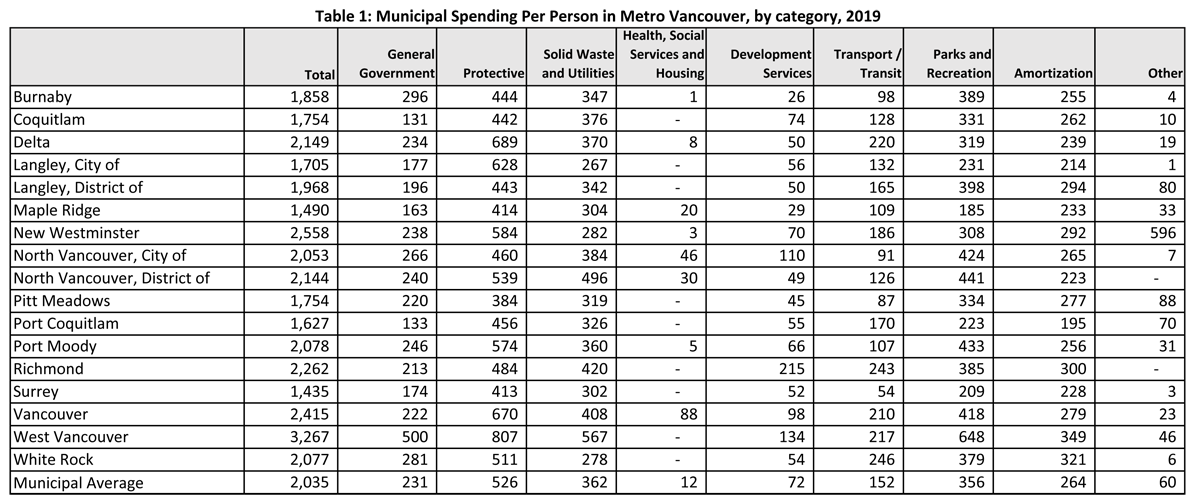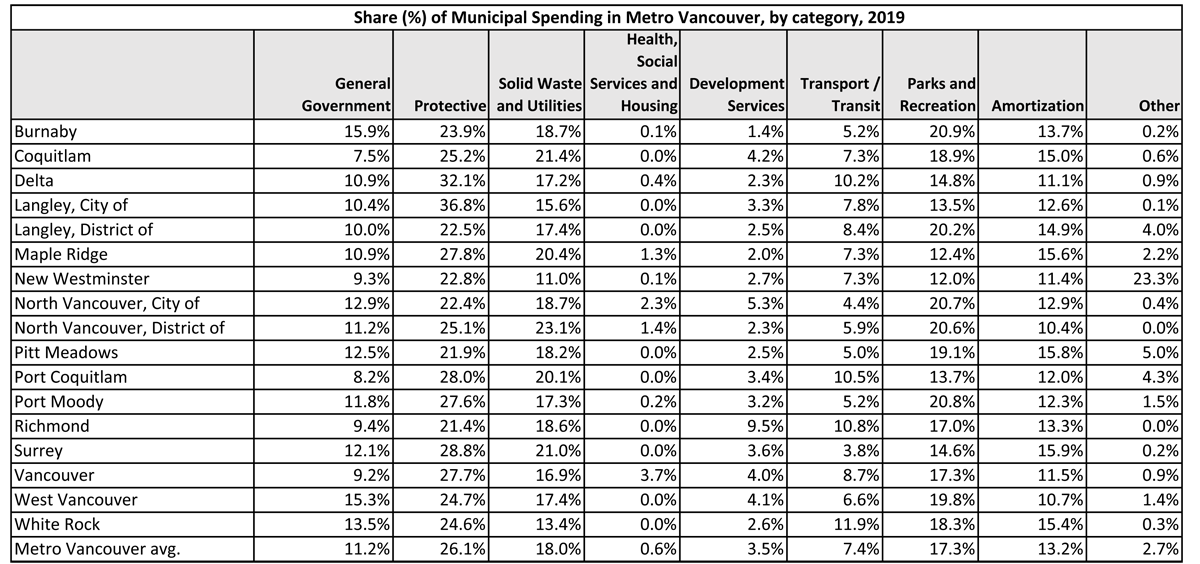What are the top spending categories for Metro Vancouver municipalities?

A recent study documented the level of per-person spending and its growth across the 17 municipalities in Metro Vancouver from 2009 to 2019. This blog post examines the categories of spending by function to better understand the nature of overall municipal spending in the region.
This post relies on the same data used in the study, which is provided by the British Columbia government through its Local Government Statistics database. Information is provided regarding spending on General Government, Protective Services, Waste and Utilities, Social Services, Development Services, Transport and Transit, Parks, Recreation and Culture, Amortization and Other Spending.
The first table (at bottom) presents per-person spending for each category for Metro Vancouver municipalities in 2019 while the second table presents the same data as a percentage of the total.
Protective Services was the largest category of spending in Metro Vancouver in 2019 at an average of 26.1 per cent of total spending. Protective Services includes police operations, fire protection operations, bylaw enforcement operations and other protective services such as emergency preparedness.
Of the 17 municipalities, the City of Langley allocated the highest share of spending at 36.8 per cent for Protective Services while West Vancouver recorded the highest dollar value of pe- person spending in 2019 at $807. Richmond allocated the smallest overall share (21.4 per cent) to this category of spending while Pitt Meadows recorded the smallest per-person level of spending ($384).
Solid Waste and Utilities was the second-highest category of spending at an average of 18.0 per cent across the region. It includes solid waste management and supplying, storing, treating and transporting potable and irrigation water—and the collection, storage, handling, treatment, transportation, discharge and destruction of solid waste.
The District of North Vancouver allocated the highest share of total spending at 23.1 per cent to this function while West Vancouver spent the most per person ($567). In contrast, New Westminster allocated the smallest share of total spending to Solid Waste and Utilities at 11.0 per cent and City of Langley spent the least ($267). New Westminster has a unique electrical utility captured in the Other Spending category, for which it has the highest share of per-person spending—it has the only municipally-owned and operated electrical utility in Metro Vancouver.
The third-highest category of spending in 2019 was Parks and Recreation—averaging 17.3 per cent of spending across Metro Vancouver. The category includes greenspace, trails, beaches, playing fields, golf courses, ski areas, public squares, swimming pools, skating rinks, curling rinks, gymnasiums, racquet courts, exercise areas, libraries, galleries, museums, community halls, performing arts theatres and heritage conservation programs.
Burnaby allocated the highest share of spending to this category (20.9 per cent) while West Vancouver spent the most per person in 2019 ($648). New Westminster allocated the lowest share of spending to Parks and Recreation (12.0 per cent) while Maple Ridge spent the least per person ($185).
Amortization was, on average, the fourth-highest share of total spending at 13.2 per cent in 2019. Amortization costs relate to capital-type projects that provide benefits over time such as community centres. Amortization allows the costs of such projects to be spread over a similar time period during which the asset provides benefits to the community, rather than incurring all of the cost when it’s built. This is standard practise in the private sector.
Surrey allocated 15.9 per cent, the highest share of total spending, to amortization costs and West Vancouver again had the highest level of per-person spending on Amortization at $349. The District of North Vancouver allocated the lowest share of total spending (10.4 per cent) to Amortization while Port Coquitlam spent the lowest amount ($195) per person in 2019.
The fifth-highest category of spending and the only remaining category above the 10 per cent threshold was General Government, with 11.2 per cent of spending on average. General Government includes the basic costs of running government—administration, finance, human resources and information systems.
Burnaby allocated the largest share of total per-person spending (15.9 per cent) to General Government while West Vancouver recorded the highest level of per-person spending ($500) for this category of spending. By contrast, Coquitlam allocated the lowest share (7.5 per cent) to General Government and spent the least per person in 2019 ($131).
Regional averages for spending for the remaining categories are all below 10 per cent of total spending: Transport and Transit (7.4 per cent), Development Services (3.5 per cent), Other Expenses (2.7 per cent) and Social Services (0.6 per cent).
Please note that the spending data for transportation and transit by Metro Vancouver municipalities do not include spending by TransLink. Municipal services such as road maintenance and municipal parking are included in transportation and transit.
The data provided in these tables detail the nature of per-person spending across the municipalities in Metro Vancouver and provide residents a better understanding of the spending priorities of their local governments in 2019.
Notes: Other spending includes any municipal function that does not fall under the previous categories, such as cemetaries and airports and other utilities; loss on disposition of assets; other adjustments that do not easily fit into any of the other functional categories. Spending on transportation and transit by Metro Vancouver municipalities does not include spending by TransLink or, in the case of West Vancouver, spending that is reimbursed by TansLink. Municipal services such as road maintenance and municipal parking are included in transportation and transit. The municipal average is the average of per-person spending of the 17 Metro Vancouver municipalities.
Sources: British Columbia, 2022a, 2022b; British Columbia, Ministry of Municipal Affairs and Housing, 2022; calculations by authors.
Authors:
Subscribe to the Fraser Institute
Get the latest news from the Fraser Institute on the latest research studies, news and events.



